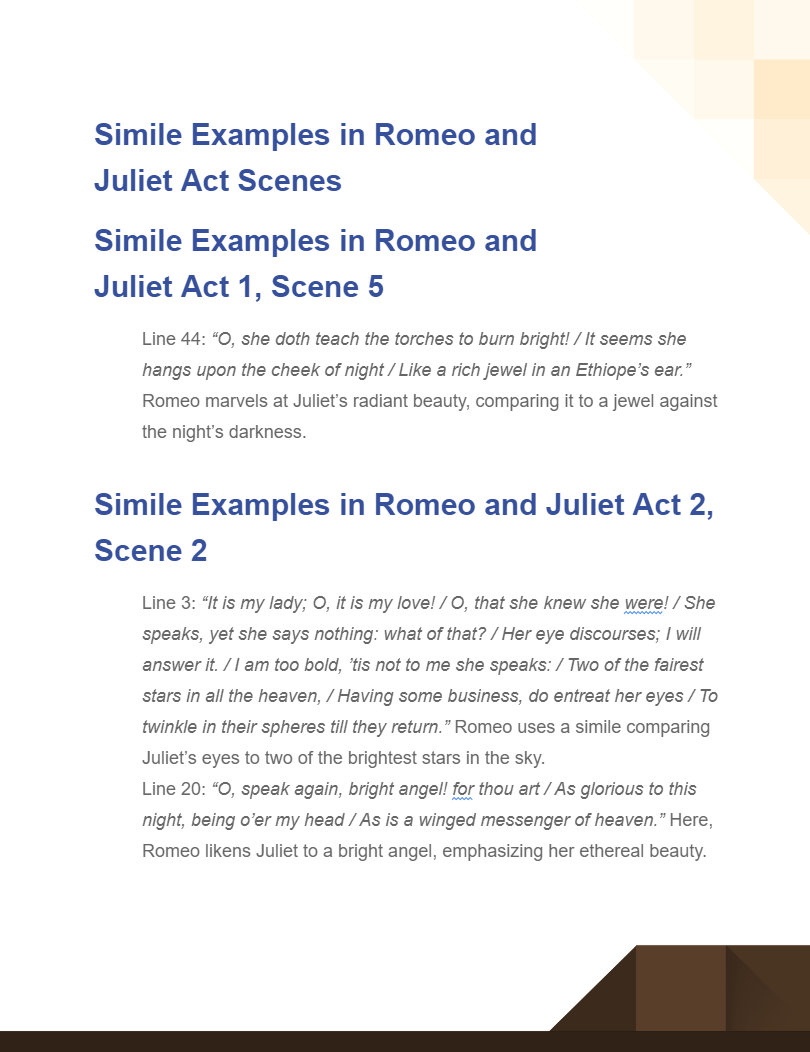8+ Simile in Romeo and Juliet Examples
In the intricate tapestry of Shakespeare’s “Romeo and Juliet,” similes are the golden threads weaving passion, conflict, and beauty together. As we embark on this journey, we’ll unveil the Bard’s brilliance in capturing love’s essence through his crafty use of simile examples, while also providing insights on penning them yourself. Join us as we explore these poetic gems and the art behind them.
What is a Simile in Romeo and Juliet? – Definition
A simile, as a literary device, is a figure of speech that makes a comparison between two distinct objects using words such as “like” or “as”. In “Romeo and Juliet,” Shakespeare deftly employs similes to magnify emotions, describe characters, and set atmospheric tones. By comparing seemingly disparate elements, similes help create vivid imagery and deepen the readers’ understanding of the characters and their world.
What Is the Best Example of Simile in Romeo and Juliet?
While “Romeo and Juliet” is rife with exquisite similes, one that stands out pertains to Juliet’s beauty in Act 2, Scene 2:
“O, speak again, bright angel! for thou art / As glorious to this night, being o’er my head / As is a winged messenger of heaven.”
In this simile, Romeo compares Juliet to a bright angel, suggesting that her beauty and presence are divine and ethereal. The comparison accentuates Juliet’s purity, radiance, and the overwhelming impact she has on Romeo, elevating their love to a celestial realm. This powerful imagery not only underscores the intensity of their love but also foreshadows the tragic, almost otherworldly dimensions their story will take.
Famous Similes in Romeo and Juliet
Delving into “Romeo and Juliet,” Shakespeare’s poetic genius becomes evident through his liberal use of similes. These comparisons breathe life into the narrative, etching memorable visuals in the reader’s mind.
Simile Examples in Romeo and Juliet Act Scenes

Simile Examples in Romeo and Juliet Act 1, Scene 5
- Line 44: “O, she doth teach the torches to burn bright! / It seems she hangs upon the cheek of night / Like a rich jewel in an Ethiope’s ear.” Romeo marvels at Juliet’s radiant beauty, comparing it to a jewel against the night’s darkness.
Simile Examples in Romeo and Juliet Act 2, Scene 2
- Line 3: “It is my lady; O, it is my love! / O, that she knew she were! / She speaks, yet she says nothing: what of that? / Her eye discourses; I will answer it. / I am too bold, ’tis not to me she speaks: / Two of the fairest stars in all the heaven, / Having some business, do entreat her eyes / To twinkle in their spheres till they return.” Romeo uses a simile comparing Juliet’s eyes to two of the brightest stars in the sky.
- Line 20: “O, speak again, bright angel! for thou art / As glorious to this night, being o’er my head / As is a winged messenger of heaven.” Here, Romeo likens Juliet to a bright angel, emphasizing her ethereal beauty.
Simile Examples in Romeo and Juliet Act 2, Scene 6
- Line 3: “Then love-devouring death do what he dare; / It is enough I may but call her mine.” Friar Lawrence uses a simile to equate death to a force that devours love.
Simile Examples in Romeo and Juliet Act 3, Scene 5
- Line 9: “Night’s candles are burnt out, and jocund day / Stands tiptoe on the misty mountain tops.” Here, Romeo employs a simile, likening stars (night’s candles) to extinguished lights, indicating the approach of dawn.
- Line 20: “More light and light; more dark and dark our woes!” Romeo uses contrasting imagery, suggesting that as daylight grows, their problems deepen, likening the increasing light to the weight of their sorrow.
Simile Examples in Romeo and Juliet Act 4, Scene 3
- Line 38: “That almost freezes up the heat of life.” Juliet, before drinking the potion, describes her fear. She uses a simile to convey the potion’s effect, comparing its chilling force to a halt in life’s warmth.
- Line 57: “As in a vault, an ancient receptacle, / Where, for this many hundred years, the bones / Of all my buried ancestors are packed.” Juliet paints a haunting image by likening the tomb to a storage place, emphasizing the weight of her family history.
Simile Examples in Romeo and Juliet Act 4, Scene 5
- Line 24: “Death lies on her like an untimely frost / Upon the sweetest flower of all the field.” The comparison here accentuates Juliet’s innocent beauty. Her presumed death is compared to an early frost that kills a beautiful flower, a poignant visualization of her tragic end.
Simile Examples in Romeo and Juliet Act 5, Scene 1
- Line 83: “Is it e’en so? Then I defy you, stars!” Romeo, upon hearing of Juliet’s “death”, likens his fate to written in the stars, challenging the cosmic forces that have seemingly conspired against their love.
- Line 95: “Like powder in a skilless soldier’s flask, / Is get afire by thine own ignorance.” Romeo speaks of fate, using a simile to compare it to a soldier’s mismanaged gunpowder that can accidentally ignite.
Simile Examples in Romeo and Juliet Act 5, Scene 2
- Line 6: “Now are they dead, then deadly are our looks.” Here, Friar John uses a simile to describe the consequences of their missed message, equating the absence of news to a deadly outcome.
- Line 38: “My heart is wondrous light / Since this same wayward girl is so reclaimed.” Paris, speaking of Juliet, employs a simile to suggest that his heart feels as light as air due to the apparent change in Juliet’s demeanor.
Simile Examples in Romeo and Juliet Act 5, Scene 3
- Line 89: “Thou detestable maw, thou womb of death, / Gorged with the dearest morsel of the earth, / Thus I enforce thy rotten jaws to open, / And, in despite, I’ll cram thee with more food!” Romeo, in a moment of anguish, describes the tomb using a simile, likening it to a monstrous mouth, ready to devour and consume.
- Line 101: “Death, that hath sucked the honey of thy breath, / Hath had no power yet upon thy beauty.” In this poignant moment, Romeo observes Juliet, believing her to be dead. He uses a simile to illustrate that while death has taken her life (the honey of her breath), it has failed to diminish her beauty.
- Line 309: “As that the weeping should o’ertop the bounds of modesty.” Prince Escalus reflects on the tragic events, comparing the weight of sorrow to an overwhelming flood that breaks the dams of modesty.
How to Identify a Simile in Romeo and Juliet Poem? – Step by Step Guide
1. Understand the Basics of a Simile
First and foremost, know what a simile is. It’s a figure of speech that directly compares two unlike things using “like” or “as”. Familiarize yourself with these linking words as they often signal a simile’s presence.
2. Read the Passage Aloud
When you verbalize Shakespeare’s words, you’re more likely to catch the rhythm and nuances of his language. Similes often stand out when heard.
3. Look for Descriptive Comparisons
Search for passages where characters describe something by comparing it to something else. If Romeo describes Juliet’s beauty by comparing it to something familiar yet distinct, there’s a good chance you’ve found a simile.
4. Highlight Linking Words
As you comb through the text, underline or highlight instances of “like” or “as”. This action will make potential similes pop out as you read.
5. Contextual Understanding
Ensure that the identified simile fits contextually. A mere presence of “like” or “as” doesn’t guarantee a simile if the sentence isn’t making a descriptive comparison.
6. Cross-Reference with Annotations
Many editions of “Romeo and Juliet” come with annotations. Cross-referencing your identified similes with these can confirm your findings.
7. Practice Makes Perfect
The more you read and familiarize yourself with Shakespeare’s poetic devices, the more adept you’ll become at spotting similes effortlessly.
Tips to Writing Similes like Romeo and Juliet Poetry
1. Tap into Emotion
Shakespeare’s similes resonate because they stem from deep emotions. When crafting your simile, ensure it emerges from a genuine emotional space.
2. Use Vivid Imagery
Your comparison should paint a picture. Instead of saying “cold as ice,” perhaps describe something as “cold as a winter’s moonlit night.”
3. Keep it Relevant
Ensure your simile fits the theme or mood of your poem. A light-hearted simile might not fit in a tragic or serious setting.
4. Avoid Clichés
Steer clear of overused comparisons. The beauty of Shakespeare’s similes is their originality.
5. Test It Out Loud
Reading your simile aloud can help you gauge its rhythm and impact. If it sounds off or forced, it might need refining.
6. Consider Cultural Context
What’s universally understood in one culture might not resonate in another. Ensure your simile has broad appeal or is fitting for your target audience.
7. Simplicity is Key
While it’s tempting to craft complex comparisons, the most effective similes are often simple and direct, creating a powerful, immediate impact.
8. Study Shakespearean Similes
The best way to write like Shakespeare is to immerse yourself in his works. Identify and analyze his similes, understanding the depth and context behind each.
9. Seek Feedback
Share your similes with peers or mentors. Fresh eyes can provide valuable insights and suggestions.
10. Keep Writing
The more you practice, the more refined and impactful your similes will become. Embrace the journey of poetic discovery.
By immersing yourself in Shakespeare’s works and practicing your craft diligently, you can harness the power of similes to create compelling and evocative poetry, echoing the brilliance of the Bard himself.


